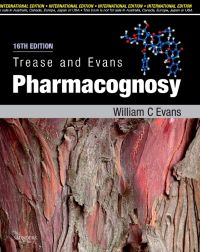‘Trease and Evans’ is an encyclopedic reference work on pharmacognosy – the study of those natural substances, principally plants that find a use in medicine. Its popularity and longevity stem from the book’s balance between classical (crude and powdered drugs’ characterization and examination) and modern (phytochemistry and pharmacology) aspects of this branch of science, as well as the editor’s recognition in recent years of the growing importance of complementary medicines, including herbal, homeopathic and aromatherapy.
New to this edition
- New chapter on 'Neuroceuticals'.
- Addition of many new compounds recently added to British Pharmacopoeia as a result of European harmonisation.
- Considers development in legal control and standardisation of plant materials previously regarded as 'herbal medicines'.
- More on the study of safety and efficacy of Chinese and Asian drugs.
- Quality control issues updated in line with latest guidelines (BP 2007).
Key Features
- New chapter on ‘Neuroceuticals’
- Addition of many new compounds recently added to British Pharmacopoeia as a result of European harmonisation
- Considers development in legal control and standardisation of plant materials previously regarded as ‘herbal medicines’
- More on the study of safety and efficacy of Chinese and Asian drugs
- Quality control issues updated in line with latest guidelines (BP 2007)
Author Information
By William Charles Evans, BPharm, BSc, PhD, DSc, FIBiol, FLS, FRPharmS, Formerly Reader in Phytochemistry, University of Nottingham, Nottingham, UK
Part 1: Introduction
Plants in medicine: the origins of pharmacognosy
The scope and practice of pharmacognosy
Plant nomenclature and taxonomy
Part 2: The plant and animal kingdoms as sources of drugs
Biological and geographical sources of drugs
A taxonomic approach to the study of medicinal plants and animal-derived drugs
Pharmacological activities of natural products
Synergy and other interactions in phytomedicines
Traditional plant medicines as a source of new drugs
Discovering new lead compounds in pharmaceutical research and development
Part 3: Principles related to the commercial production, quality and standardization of natural products
Commerce in crude drugs
Production of crude drugs
Plant growth regulators
Plant cell and tissue culture; biological conversions; clonal propagation
Phytochemical variation within a species
Deterioration of stored drugs
Quality control
Part 4: Phytochemistry
General methods associated with the phytochemical investigation of herbal products
Basic metabolic pathways and the origin of secondary metabolites
Part 5: Pharmacopoeial and related drugs of biological origin
Introduction
Hydrocarbons and derivatives
Carbohydrates
Phenols and phenolic glycosides
Volatile oils and resins
Saponins, cardioactive drugs and other steroids
Miscellaneous isoprenoids
Cyanogenetic glycosides, glucoinolate compounds and miscellaneous glycosides
Alkaloids
The search for naturally-derived anticancer agents
Antiprotozoal natural products
An overview of drugs with antihepatotoxic and oral hypoglycaemic activities
Antibacterial and antiviral drugs
Vitamins and hormones
The plant nutraceuticals
Colouring and flavouring agents
Miscellaneous products
Part 6: Plants in complementary and traditional systems of medicine
Introduction
Herbal medicine in Britain and Europe: regulation and practice
Asian medicine
Chinese herbs in the West
Plants in African traditional medicine - some perspectives
Part 7: Nonmedicinal toxic plants and pesticides
Hallucinogenic, allergenic, teratogenic and other toxic plants
Pesticides of natural origins
Part 8: Morphological and microscopical examination of drugs
Plant description, morphology and anatomy
Cell differentiation and ergastic cell contents
Techniques in microscopy
Index
"The book is a wealth of multi-disciplinary information, including a synopsis of plant morphology and anatomy, plant taxonomy with notes on the families of flowering plants and their products, commercial plant drug production, ethnopharmacology, and metabolic pathways and secondary metabolites. Here is an essential reference work that also justifies why plants and botany are so vital to human life." Plant Talk, January 2004
"...book has been extensively revised, certain sections rewritten and additional chapters by specialist contributors included, bringing it up to date in the ever advancing field of pharmacognosy. Each section of the book is well presented with current and comprehensive referencing plus relevant illustrations. This bigger and better edition has much to offer those working in the field of phyto-medicine including aromatherapists and educators. It constitutes a 'must have' text." The International Journal of Aromatherapy




